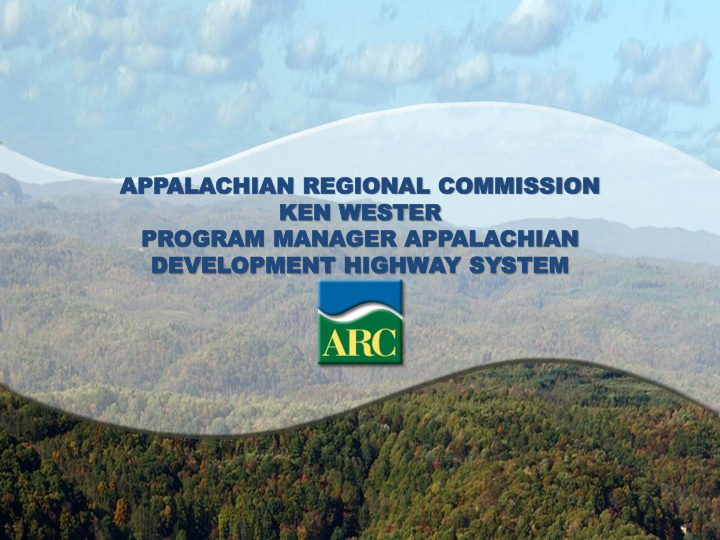



APP APPALA ALACH CHIAN IAN REG REGIO IONAL AL CO COMMISSIO MMISSION KE KEN N WESTER WESTER PR PROG OGRA RAM M MAN MANAGE GER R APP APPALA ALACH CHIAN IAN DEV DEVEL ELOP OPMENT MENT HI HIGH GHWA WAY Y SY SYSTEM STEM
ARC’s Mission ARC’s mission is to be a strategic partner and advocate for sustainable community and economic development in Appalachia. Our goal is to bring Appalachia into socioeconomic parity with the rest of the nation.
Appalachian Region 13 states 420 counties 205,000 sq. miles 24.8 million people 73 local development districts
Appalachian Regional Commission Federal representative = 1 vote 13 Appalachian Governors = 1 vote Federal Co-Chair 13 Governors / States’ Co -Chair Federal Alternate Governors’ Alternates Federal Office States’ Washington Office Inspector General Executive Director General Counsel Local Development Districts Public Affairs Regional Planning and Regional Program Finance and Research Operations Administration Transportation Entrepreneurship Telecommunications Publications
ARC Strategic Goals Jobs Education and Training Infrastructure Highways (ADHS)
The Appalachian Development Highway System “ Developmental activity in Appalachia cannot proceed until the regional isolation has been overcome…. Its penetration by an adequate transportation network is the first requisite of its full participation in industrial America.” “This system is based upon criteria different from those normally employed.... [A] developmental system seeks to stimulate the flow of people and goods to and through remote areas which have a developmental potential….” President’s Appalachian Regional Commission 1964
Appalachian Regional Development Act of 1965 • Authorized 2350 miles • Authorized $840 million for construction • Projected total cost to complete of $1.2 billion
Proposed Appalachian Development Highway System Report by the President’s Appalachian Regional Commission, 1964
History of Mileage Added • 1967 – Added 350 miles (Corridors T and U) • 1975 – Added 200 miles (Corridor V) • 1978 – Added 125 miles (Corridor X and relocation of Corridor A) • 2004 – Added 65 miles (Corridor X-1)
Current Appalachian Development Highway System Status as of September 30, 2010
ADHS – Economic Impact • Completion of the ADHS will yield by 2035 – – 80,500 jobs – $3.2 billion annually in increased wages – $2.1 billion annually in value-added economic activity – National travel efficiency savings of $5.1 billion annually – A national return of $3 for every $1 invested in completing the ADHS
Current Challenges • Completing the ADHS • Linking Economic Development and Transportation Planning • Planning and Coordination – Modes, Disciplines (Public and Private), Jurisdictions • Transitioning to Global Economy – Access to the Ports • Understanding Economic and Commodity Flow Trends affecting the Region
CO CONC NCLUSIO USION: N: TRA TRANSPOR NSPORTATION TION H HAS AND AS AND CA CAN N ENHA ENHANC NCE E ECON ECONOM OMIC IC SUST SUSTAIN AINAB ABILITY ILITY – BUT UT
Recommend
More recommend